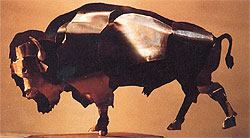Copper Buffalo to Roam Wyoming
Buffalo will again roam the Oregon Trail. Solid copper buffalo, that is. Some 1,000 of them, each using up to 750 pounds of copper sheet and measuring up to 10 feet long and 6 feet tall, are planned for a half-mile of Wyoming prairie in time to celebrate the trail's sesquicentennial in 1993.
"We have room for more than 8,000 buffalo in the Beaver Rim area, located south of Riverton and east of Lander," says famed U.S. sculptor Robert Berks. Berks' concept of the Great Buffalo Herd Monument promises to be the biggest tourist attraction in the West since Mount Rushmore. The project has the endorsement of U.S. Secretary of Interior Manuel Lujan, the Wyoming Division of Tourism, the Fremont County Commissioners and the Lander City Council along with developmental assistance from the National Buffalo Association, among others.
The estimated $50- to $90-million project will include a complete herd of bulls, cows and calves in their natural proportions, all welded from 1 /4-inch and 1 /8-inch thick copper sheets. For comparison, the Statue of Liberty is made of 1/10-inch copper.
 Each buffalo will be built with a pivot under its front hooves so that the stylized sculptures will swivel freely like weather vanes, always pointing into the wind in the same way real buffalo graze. A sound mechanism will be installed in each to recreate the buffalo's natural lowing sounds as it turns in the wind. The sculptures are designed to withstand 200 mph winds and temperatures down to -40F.
Each buffalo will be built with a pivot under its front hooves so that the stylized sculptures will swivel freely like weather vanes, always pointing into the wind in the same way real buffalo graze. A sound mechanism will be installed in each to recreate the buffalo's natural lowing sounds as it turns in the wind. The sculptures are designed to withstand 200 mph winds and temperatures down to -40F.
Berks sees the copper herd as a "monument for the ages, lasting a thousand years and requiring an absolute minimum of maintenance." The Long Island, New York, sculptor says this is "because of the relatively maintenance-free properties of copper." However, because he desires to keep the copper from developing its characteristic blue-green patina, Berks envisions the copper will remain "buffalo brown" through the application of a special coating every 15 years.
Aside from its natural beauty and resistance to weather, Berks chose copper because, "once annealed, copper is one of the easiest materials that can be worked cold." In other words, once the copper sheet has been heat-softened, it can be easily hammered or bent to the artist's desired shapes.
The herd of unique sculptures will be arrayed near the South Pass of the Oregon Trail in the configuration of a giant buffalo that can be identified from the air. According to Berks, "You will be able to see it from the moon. It will be one of the largest works of art in the history of mankind." Plans for the mammoth project include parking and visitor facilities. "We expect to draw visitors from around the world," Berks says.
Berks sees the project as a time machine. "What this country did to the buffalo and how people have restored them is an example of how we can recover from environmental abuses. This [monument] will give people the chance to see what the ancient herds looked like, but unlike real buffalo, which are wild, dangerous animals, these animals will be stationary. People will walk among them and get the feel of just how vast those herds were," he says.
Also in this Issue:
- NASA Relies on Copper for Shuttle Engine
- Copper Buffalo to Roam Wyoming
- Demand Increases for Copper Busbars
- Solid Brass Padlocks Now Available to Consumers
- Special Coatings, Packaging Products Keep the Shine on Copper and Brass
- Copper Use in Autos Up 40 Percent
- Copper Wire Ensures Performance of New Antilock Brake System
- Copper to Replace Aluminum in New Chip Technology
